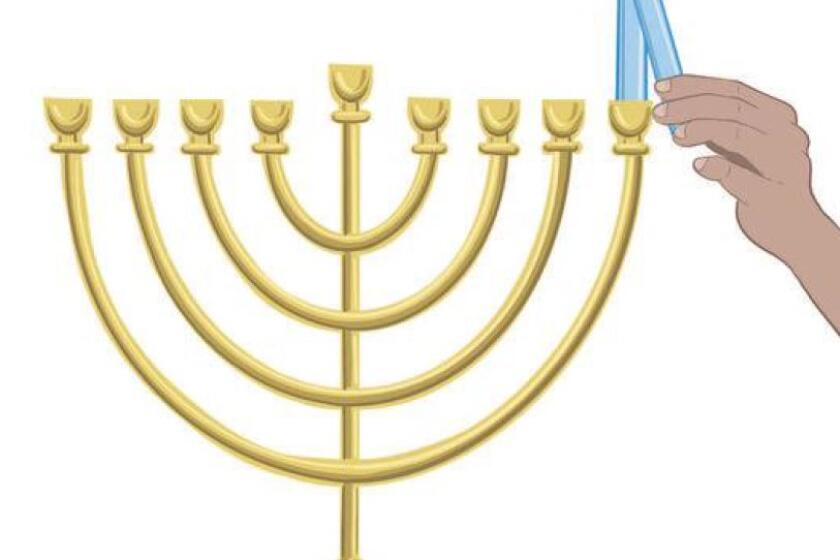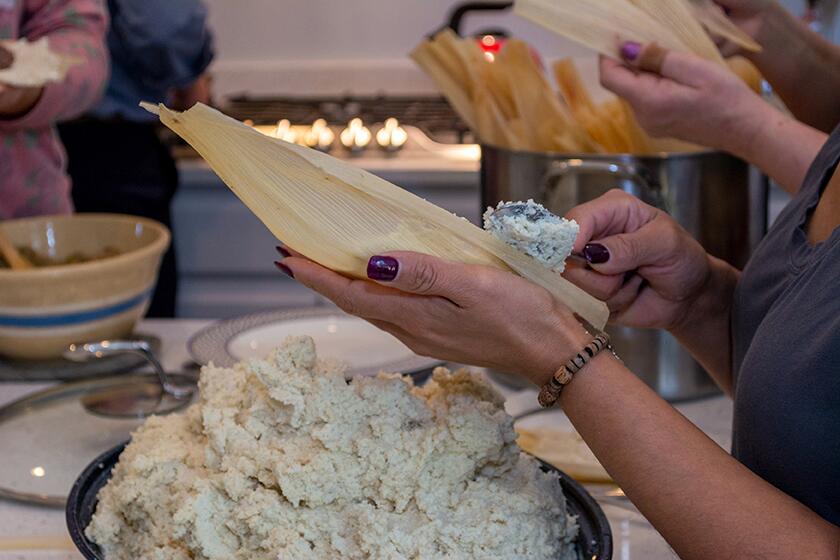Opinion: My favorite Hanukkah meal is fresh in my memory

A typical Hanukkah feast in my family usually includes a fried dish or two, and the oil used in frying commemorates the sacred oil used in the rededication of the Second Temple in Jerusalem.
Feldman is a recipe developer, food stylist, TV show host and author. She grew up in La Jolla and now lives in Los Angeles. She is on Instagram, @noshwithtash.
For me, the most cherished, nostalgic and joyful part of any holiday celebration is the food. Not the decorations, gifts or songs, but the food. And I can honestly say that as a chef, I don’t endeavor to reinvent my favorite family recipes, but to be true to them in all of their glorious simplicity and comfort.
In my family, culture and tradition are very important. (If this were a speech, rather than an essay, this is when I would launch into “Tradition” from “Fiddler on the Roof.”) In my world, food is the truest, most experiential way to honor this.
The deeper meaning of Hanukkah is to affirm who we are.
Maya is an advertising executive, producer and writer who lives in Chula Vista.
We provide this platform for community commentary free of charge. Thank you to all the Union-Tribune subscribers whose support makes our journalism possible. If you are not a subscriber, please consider becoming one today.
We provide this platform for community commentary free of charge. Thank you to all the Union-Tribune subscribers whose support makes our journalism possible. If you are not a subscriber, please consider becoming one today.
My great-great-grandma Clara was a mythical cook and baker, and although my mom and I never met her, we really do feel connected through the recipes that mom inherited on yellowed index cards. Clara lived into her 90s despite enduring unimaginable hardships. By the time she was able to immigrate to America, only two of her 11 children were alive to take the arduous journey in steerage to Ellis Island. She also outlived three husbands. She was both a great cook and a tough cookie, and I love holding that image of her in my heart.
A typical Hanukkah feast in my family usually includes a fried dish or two, and the oil used in frying commemorates the sacred oil used in the rededication of the Second Temple in Jerusalem. Hanukkah is known as the Festival of Lights, and on Kislev 25 (which can fall delightfully close to Christmas, or, frankly, too near to the Thanksgiving feast) we light the first candle, and light an additional candle for all eight nights.
The lighting of the candles and traditional prayers are very peaceful. I mean, who doesn’t love a flickering candle? Ideally, you take a moment to reflect and be together, but, of course, I am usually sidetracked with anticipating the delicious meal.
My family comes from Eastern Europe, and as Ashkenazic Jews we traditionally serve potato pancakes — aka latkes — with applesauce and sour cream. Jews from other parts of the world typically eat deep fried puffed fritters. Jelly donuts are also a delicious option.
But circling back to potato latkes, mmmm.
Here’s the good and the bad. The good thing is that they are truly delicious. The bad thing is that they require a lot of labor. You have to grate and wring out the liquid from the potatoes, stand over a sizzling frying pan that is constantly spitting hot angry oil at you, and cook them in batches while sweating profusely, praying that the scalding oil burns on your skin don’t result in a wound that will remind you of latkes for years to come. My mom simplified this by buying a boxed latke mix, and although they’re not as fabulous as the original, there is no shame in making your life simpler, and they’re pretty tasty! That being said, I wear my latke wounds as a badge of honor and always make my latkes from scratch.
But my favorite, most beloved Hanukkah dish, which must be the centerpiece of my table, is brisket.
Brisket is a cut of beef that comes from the lower chest of the cow, and since that muscle holds up the majority of the cow’s weight, there’s lots of connective tissue, and that results in a tough cut of beef. But as all of us brisket lovers know, this almost reasonably priced cut is amazingly tender and delicious when braised, aka slowly roasted. My favorite Hanukkah brisket, lovingly prepared by at least four generations of my family, is braised with lots of tart/sweet dried fruit.
As we all know, fried food doesn’t benefit from sitting around and being served less than hot and crisp. There is really no clamoring for two-day-old fried anything. I’ve never met someone who has said, you know, I really love day-old fish and chips. If this is you, please make yourself known.
On the other hand, a brisket gets better the second day. The really wonderful thing is that all of the work, and related mess, is on day one. Refrigerate overnight and then just reheat the day of. And what’s even better than day two brisket? Day three brisket, obviously.
I love converting the leftovers into a brisket sandwich with a lot of horseradish. Or, brisket pasta, which I think is my greatest culinary accomplishment to date.
My favorite Hanukkah menu is brisket, latkes with sour cream (topped with thinly sliced green onion) and applesauce doused in cinnamon. To balance the richness of the brisket and latkes, I love to serve a slightly blistered roasted veggie (such as broccolini with lemon zest) or a green salad with lots of dill and parsley.
So I’d like to raise a toast to my great-great Bubbe Clara and to all of the cooks out there preparing their holiday meals for beloved friends and family.
You’re creating loving memories that will last a lifetime.
Get Weekend Opinion on Sundays and Reader Opinion on Mondays
Editorials, commentary and more delivered Sunday morning, and Reader Reaction on Mondays.
You may occasionally receive promotional content from the San Diego Union-Tribune.








